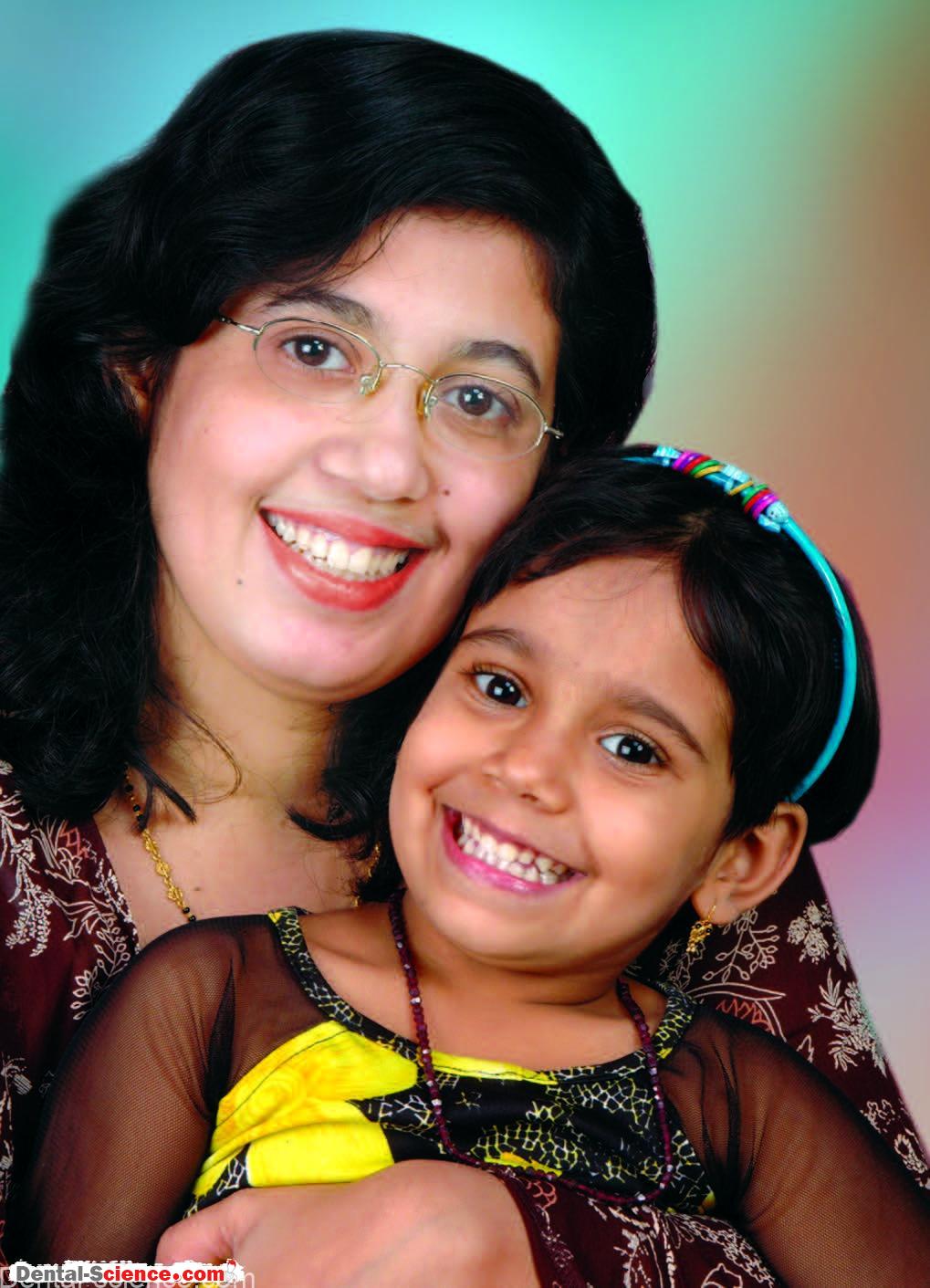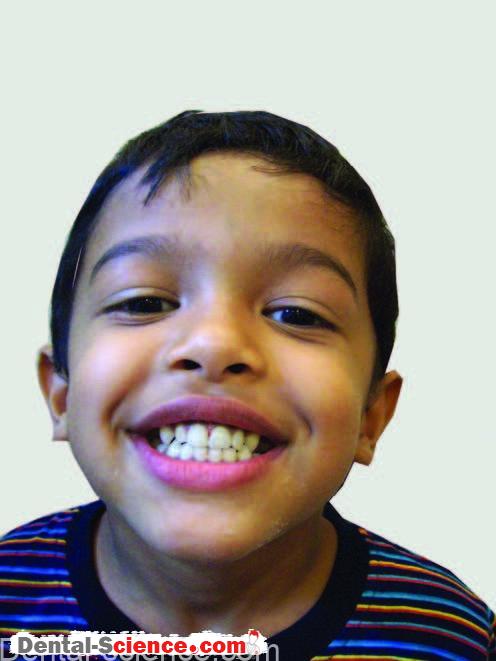“Needle Phobia”—No More!
– It is not easy to inject a child, even though it ensures pain relief!
– “Needle Phobia” does exist in children and at times in adults, too!
– Also, we as dental surgeons are scared to inject a child prior to dental treatment!
– (On a lighter note, we are needle-phobic, too!)
– Local anesthesia is mandatory for most dental procedures.
–If we fail to achieve adequate anesthesia, we can rarely accomplish treatment with ease.
– The advantages of local anesthesia, therefore, need not be over-emphasized.
– It is an acquired skill of a dentist to administer local anesthesia to a child patient.
– The most crucial part of a pediatric dental procedure is the successful administration of local anesthesia since the cooperation of the child, and subsequently, the quality of dental
treatment, depends on it.
Why are children scared of injections?
– An important deterrent to seeking dental care is fear of injections.
– Often, parents threaten a child that the child would be taken to a doctor if he/she
misbehaves or an injection would be given by the doctor for eating too many chocolates!
– Also, the FEAR associated with injections lowers the pain threshold and thus, the intensity of pain increases when it has to be experienced.
– The anxiety of parents could be another important reason for a child’s negative preparation of mind.
– Parents, family members, friends expressing their own concerns in front of children in
relation to pain, bleeding, tooth removal, injections, etc.
– may influence a child negatively.
– At times, the presence of an anxious parent in the operatory can affect the administration of local anesthesia adversely, as the child in presence of such a parent would be obviously more worried and fearful.
– A past negative (painful) experience is another factor associated with fear.
– However, many a time such an experience is not due to painful injections per se, but is due to lack of pre-treatment preparation of the child or lack of adequate pain control (either due to failed/inadequate anesthesia) during treatment.
– One must believe that only a good painless administration would restore the child’s
confidence in receiving local anesthesia.
– The following discussion outlines the necessary steps to be followed for the same.
Preparation of parents prior to local anesthesia for children
– A discussion with parents prior to any procedure should help them prepare themselves better for a child’s dental care.
– The same may preferably take place in absence of children.
– Certain instructions need to be given to parents for better preparation of them and their
children for receiving dental treatments; such as:
• Do not tell your child about pain, blood, injections, etc. in the first place.
• Don’t tell him/her something like – “ because you don’t brush you teeth properly, doctor will give you an injection…” or “because you eat chocolates, your spoiled teeth will be removed by doctor”!
• Do not voice your own fears about dentistry (pain, blood, etc.) in front of children. Your
dentist can answer your queries separately.
• Do not insist on starting the treatment in the first visit itself. Give your doctor enough time to talk to your child. The time spent initially on building rapport and gaining his/her confidence will in turn save the time required for treatment later.
• Don’t promise him/her in advance about the time the doctor would take for the treatment, the pain he/she might get, etc. which can mislead him/her. Simply say you don’t know.
• Report to doctor any past negative experience.
– The author requests parents to wait outside the operatory during most dental treatments, including administration of local anesthesia to a child.
– This establishes a better rapport with the child.
– The 1:1 communication between a child and the doctor is the key to successful dental
treatment.
– Also, as mentioned earlier, many parents are themselves anxious about certain procedures.
– Their anxieties as well as their instructions (apart from the doctor’s) may create confusion in the child’s mind and hinder smooth delivery of care.
– The child at times may demand holding his/her mother’s hand or sitting on mother’s lap, and much more…. Remember, whenever we meet with such demands, the child senses that he/she can dominate the proceedings and that makes our job even more difficult.
– Children also know the best ways to emotionally blackmail their parents!
– It is obviously difficult to manage a combination of a ‘demanding’ child and an ‘anxious’
parent without ‘separation’!
– The ‘separation’ should take place as comfortably as possible.
– Therefore, it needs to be explained in a professional manner to the parent prior to the
treatment and the parents must willingly agree to it.
– Also, separation ensures that the child gets undivided attention of the doctor and he/she has no choice but to comply with the doctor’s demands.
– Now, the dental surgeon can use the behavior modification to the fullest efficiency.
– While treating children, we must note that we are behavior therapists and not merely
dentists.
– We must believe that if we use child management methods properly, 85-90% children can
cooperate for all dental procedures (many of them enjoy them, too)!
– Distraction by engaging the child in conversation or by showing some interesting objects, or with TV set in front of dental chair/music being played; modeling, i.e. showing another child receiving dental treatment comfortably, demonstrating procedures (Tell-Show-Do) in
simple words (using Euphemisms or substitute words), rewarding appropriate response by praising or giving gifts, etc. are a few examples of these methods.
– At times it may be necessary to restrict unwanted movements of children by holding their hands and stabilizing their heads.
– Also, it may be necessary to modulate voice to praise good behavior and discourage bad
behavior.
– Only if the child is uncooperative after these methods have been attempted, the need for pharmacological technique (general anesthesia/sedation) arises.
– The same may be explained to parents appropriately.
– The child must be made comfortable in the dental set-up.
– The dentist in the first couple of visits must focus on this aspect rather than carrying out much treatment.
– Simple procedures such as consultation and treatment planning, taking radiographs, brushing demonstration, fluoride applications, small restorations, etc. can be carried out prior to a treatment requiring administration of local anesthesia.
– The child sitting in the chair in a relaxed manner and actively participating in a conversation with the clinic staff is more likely to accept local anesthesia with ease.
– The following steps helps in a smooth administration of local anesthesia.
1. Explain the procedure to the child in brief, firm yet friendly manner.
Tell him/her that you would be “cleaning” the tooth for which you need to “put medicine near the tooth to put the tooth to sleep”.
Also, you may tell him that it may hurt only as much as an ant/mosquito bite and lasts only a few seconds. (Avoid using word like injections, pain… Always ask your assistant for LA and not injections.) Avoid answering direct questions from a child such as “are you going to give me an injection “; or “are you going to remove my tooth”.
Answer confidently that you are going to first do as you explained (“cleaning” the tooth for which you need to “put medicine near the tooth to put the tooth to sleep”) and decide the other things later! Reassure the child that nobody wants him/her to experience pain,
however, for having the teeth problem-free, treatments are required that may involve only a little bit of pain which most children bear without much discomfort.
(Remember, children do take pride in performing!)
2. Also, do not promise a child that he/she would not experience pain at all. The child might feel cheated even after a mild discomfort and would not trust you anymore.
Just avoid discussing pain. Should you explain pain, it must involve reassuring the child that it would not be more than an ant-bite or a mosquito-bite and it would be less only if he/she follows the doctor’s instructions carefully, such as not moving hands/head.
3. Do not ask questions related to past negative experience, if any. Also, do not ask questions that would bring about apprehension; for example: “Do you want to get tooth removed?” or “Are you ready for an injection?”
4. Ask ‘leading’ questions that would yield positive responses and direct the child to follow your instructions; for example: “Are you a good boy/girl?” “Do you wish to have good, problem-free teeth?” “Will you help me carry out treatments so that you have
problem-free teeth?”
5. Give compliments and remarks that boost confidence; for example: “You are a grown-up child.” “I like children who listen to me and help me in what I do for fixing problems of their teeth.”
6. Involve child in some imagination. Tell the child that he/she can receive a gift (from you) or
a reward (may be an ice-cream of his choice) from parents only after successful completion of treatment (if he/she behaves well). The discussion around such topics is
anxiety-relieving.
7. Do not over-prepare a child. If the child has been previously treated by you and is an
otherwise a cooperative child, let him/her feel that this is just another minor procedure.
8. Always use a topical anesthesia; either a flavored jelly or spray.
9. Use the thinnest gauge needle (27-30 G for infiltration, 26-27 G for blocks).
10. Do not show the child the syringe while being loaded. Do not wave the needle in front of the child. The assistant should transfer the syringe to the dentist without the child knowing about it! Screen the child’s vision with your palm, however, do not cover eyes entirely.
(In the author’s opinion cartridge syringes are difficult to hide.) The needle may be hidden in a sterile cotton roll that can be disengaged just before injecting.
11. Should the child see the needle, DO NOT PANIC. Just demonstrate how it works by ejecting a few drops on hand. Tell him/her that seeing it only increases pain.
12. Have an assistant standing on the left side close enough to restrict any unwanted
movements. Another assistant may stand towards the feet for the same.
However, do not forcibly hold the child prior to injection.
13. While administering local anesthesia, a few drops are sufficient to anesthetize mucosa.
After a couple of minutes, the required dose may be injected. (The child should not have seen the needle in first insertion, however.)
14. Distract the child by continuously talking with/him her during the injection; or alternatively ask the child to count numbers 1-30, while the tooth is being put to sleep (not aloud, of course)! It is important for a dentist to have thought of what to speak to a child while
administering local anesthesia. Talking to a child spontaneously without any prior
preparation could be difficult.
15. Immediately following administration, ask the child to rinse to his/her mouth thoroughly. This will not only remove the taste of the anesthetic solution but also divert the child’s
attention.
16. Once pain control is achieved with adequate anesthesia, it is advisable to carry out
maximum work; for example: quadrant/half arch dental treatments after
a pterygomandibular block, single visit endodontic treatment, etc.
17. Avoid giving local anesthesia in the next visit as far as possible (particularly when a child’s first experience of receiving the same has not been satisfactory or if extensive work has been accomplished during the previous visit).
Carrying out lighter work such as post-endodontic restorations or filling a small cavity can help a child forget a past traumatic experience, if any.
18. At times, voice intonation and/or physically restraining the child may be necessary for
successful administration of local anesthesia. However, pacify the child on completion of the procedure and praise good behavior. Explain to the child that he/she had been restrained from moving so as not to injure himself/herself.
19. The above mentioned steps must be followed even in the case of a definitely positive child. By this a dentist can get accustomed to deal with any child in a systematic manner, and this preparation makes the task simpler in case of an uncooperative child.
Difficult Situations
Problem | Possible way of managing |
Frequent administrations | Schedule work in such a manner that you need to give local anesthesia on |
Palatal infiltrations
| Avoid for pulp therapy and mobile extractions that can be managed with supragingival grip. Inject minimum quantity. An injection through Avoid carrying out procedures requiring palatal anesthesia in the initial visits. |
Anesthetizing young
| Wait for good 15-20 minutes after injecting; explain the child that you have tried your best to put the tooth to sleep but it has not worked well. Ask the child to bear with the pain for a while until additional intrapulpal or intraligamentary anesthesia is administered. Often, children exhibit maturity and cope up with the situation. |
Failure of local anesthesia | Rare, but may demand other pharmacological methods |
Remember
– Never fear giving local anesthesia. Avoid starting any painful treatment without proper
anesthesia.
– The child management and the pain management are interdependent.
– If one fails to achieve local anesthesia, he/she can rarely succeed in doing a good job.
– However, if one successfully administers local anesthesia, half the battle is won!
Technique of LA administration :
– The technique integrates Tell-Show-Do, Distraction and Euphemisms effectively.
– Hence, it is called as “TeDiE” technique.
– The TeDiE technique is explained below as it is carried out on a child:
– First let me explain what I am going to do. I would like to remove your tooth without hurting you and without any pain. For this you should cooperate and listen to what I say.
– As the first step I will put your tooth to sleep, so that it cannot perceive pain.
– I can do this very well by giving a medicine (the author intentionally avoids the word
injection).
– However, when I give this medicine it can hurt you like an ant bite or a mosquito bite (can be demonstrated by a slight pinch on the ventral surface of the forearm of the child).
– To give medicine very effectively (without much of pain) and put your tooth to sleep you have to do two important things for me: You should not shake your head or move when I am
giving the medicine.
– If you shake your head, it can hurt more. I am going to use a spray before the medicine which is slightly bitter.
– When I am spraying, you should close your eyes and extend your neck (look up).
– If the spray touches the eyes it can cause burning sensation (a demonstration of the spray on the child’s palm or dorsal surface of the forearm is useful occasionally).
– However, this spray will help you not to have pain when I am giving medicine to put your tooth to sleep.
– You have to allow me to put the medicine (instead of the word injection) as soon as the spray is sprayed.
– Delaying after the spray is given can necessitate repeating the spray process.
– As soon as the medicine is given I will give you water to rinse your mouth.
– Is that okay? Repeat the two instructions again before starting the local anesthetic
procedure.
– Repetition of the instructions helps the child to understand what is going to happen to him.
– Now once the child is ready, the local anesthetic spray is sprayed and the child extends the neck and closes his eyes.
– The dental assistant passes the syringe below the extended neck to the dentist.
– Then the dentist immediately inserts the needle into the sprayed area and continues verbal
reinforcement (like: it is over, don’t move, once it is done your tooth will sleep and we can remove without any pain, you will get a new tooth there or any other conversation
appropriate for the situation) and slowly deposits the solution continuing the conversation throughout the deposition.
– Immediately after this, child is instructed to wash the mouth with water for 2-3 times.
Limitations of TeDiE Technique
– Occasionally, the bitterness of the LA solution can make a younger child get up and spit saliva.
– It is better to avoid using the spray in children less than 3 to 3.5 years.
– Use of a flavored gel is preferred.
– Some children tend to look up and search for the needle in the assistant’s or dentist’s hand.
– Some children can move during the procedure in spite of repeated verbal instructions.
Advantages of TeDiE Technique
– Most often or almost always children do not see the needle at all as it is passed below the neck by the assistant (and their eyes are closed).
– Children close their eyes and the needle is inserted immediately after the spray, hence the prick of the needle is rarely felt.
– As it has been explained clearly (repeated) prior to the procedure, they do not move during the procedure as it can hurt them.
– As they do not move during the procedure which gives sufficient time for the dentist to
deposit the solution slowly, minimizing the discomfort further.
– Many a time the entire procedure is carried out within 60-90 seconds.
– Almost complete description is explained prior to the procedure; children know what is
expected of them.
– It can be taught to any dentist who is getting trained for treating children.
– The topical spray produces an almost instant numbness; where the waiting period for pricking is negligible.
– The continuous verbal reinforcements during the deposition of LA solution by the dentist
effectively distract children.
Another technique of LA administration as follows
– Usually, following conversation takes place between doctor and the child
prior to LA administration:
Doctor: Do you know you have a bad tooth full of germs in your mouth. These germs bite your tooth everyday to give you pain. Isn’t it?
Child: Yes uncle.
Doctor: We can remove those bad germs and stop tooth pain.
Child: Oh really? How? What will you do?
Doctor: Really. But for that, both of us have to help each other.
(Child may be a bit confused about what help requirement at this stage.)
Doctor: See, there are too many germs in your tooth. Because they like your tooth, they are not ready to come out of it. I would put a medicine near your tooth which is
a ‘sleeping medicine’.
As soon as that medicine enters the germs’ mouth, they will be asleep. Then we will catch them and throw them out. If we try to catch and throw them without putting ‘sleeping medicine’, they will run around and will not come out. Let me give you an example…. When you are awake and somebody picks you up and keeps you from one place to another don’t you come to know?
Child: Yes uncle.
Doctor: But at night, when you are asleep if mummy or papa picks you up and keeps you to another bed, do you get to know that?
Child: No uncle, I get to know about it only in morning.
Doctor: Yes. The same happens with these germs. We can take them out without their knowledge if they are sleeping. OK?
Child: OK uncle. But what medicine you will apply, is that painful?
Doctor: See, that’s a sleeping medicine, and that’s all. First tell me, are you ready to help me?
Child: What help?
Doctor: You can help me by keeping mouth open mouth and closing eyes because if the
medicine goes into your eyes, you would be sleeping here! Where do you want to
sleep- here or at home?
Child: At home.
Doctor: Also, you must keep quiet and not shout; otherwise the germs will come to know that
we are coming with the sleeping medicine. And most importantly, you should not move at all so that the medicine can be applied at right place. I know that all good and brave children like you follow these instructions. Are you a good boy?
Child: Yes uncle.
Doctor: And yes, it would hurt you this much, like a mosquito bite (a small pinch on the child’s
palm or cheek).
– All this communication must take place in a casual manner.
– The dentist should confidently talk to the child in such a manner that the child is able to
correlate this experience with minor painful episodes in routine life like mosquito bites, due to fall while playing, etc. which do not create any negative impression regarding the
incidence.
– Moreover, the dentist should challenge the child’s ego at this stage by saying that good/brave children can do it easily.
– This conversation may take 10-15 min.
– Once it is done, LA administration can usually be done without any hassles.
Important steps of LA administration
1. Topical anesthesia application is a must. (The gel is preferred for inferior alveolar block and PSA block, and the spray is preferred for anterior region of mouth.)
2. Use thinner needle like 26 g, 30 g for infiltrations and 25 g/26 g/27 g needles for blocks.
3. Insert the needle slowly and deposit LA solution slowly while talking to the child continuously. Sudden deposition of LA solution is painful. Withdrawal of needle also should be slow.
4. The assistant should be ready to hold the child’s hands to support the child/prevent unnecessary movement.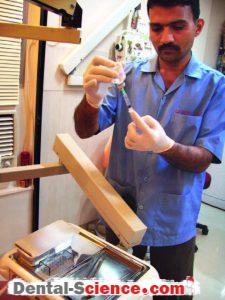
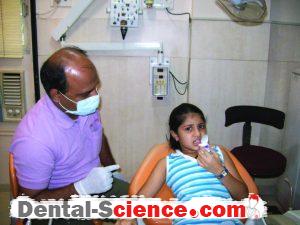
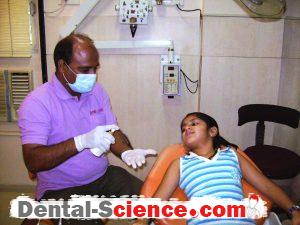
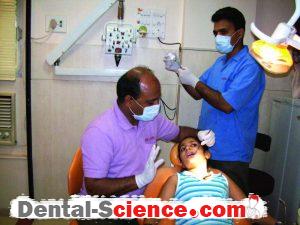
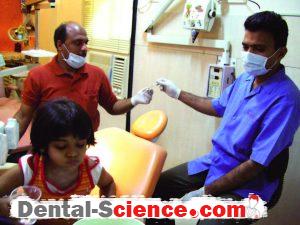
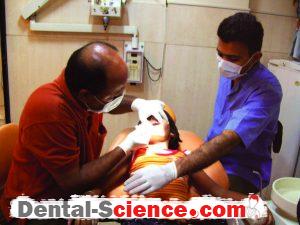
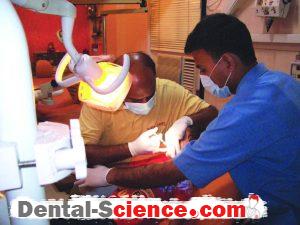
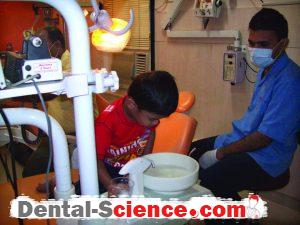
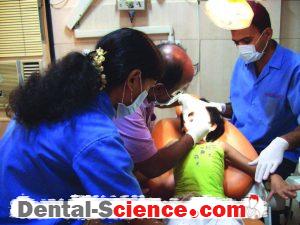
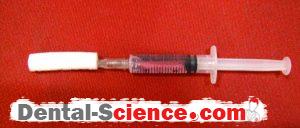

ــــــــــــــــــــ► ⒹⒺⓃⓉⒶⓁ–ⓈⒸⒾⒺⓝⓒⒺ ◄ــــــــــــــــــــ

